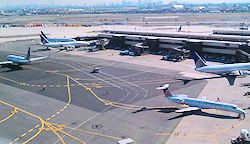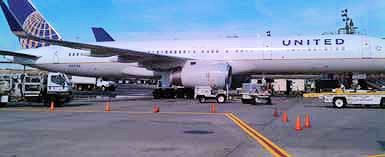 Project Clean Slate is well underway at Newark Liberty International Airport in New Jersey. The Continental Airlines initiative that began in late 2007 is steadily redesigning the carrier’s space in Terminals A and C to better accommodate aircraft with added winglets.
Project Clean Slate is well underway at Newark Liberty International Airport in New Jersey. The Continental Airlines initiative that began in late 2007 is steadily redesigning the carrier’s space in Terminals A and C to better accommodate aircraft with added winglets.
“This will increase our flexibility in gating both narrow-body and wide-body aircraft at Newark, and we feel that it will give our scheduling department greater flexibility in assigning aircraft to flights and increasing frequencies between markets,” explains Stan Kiebus, Continental’s construction manager and operational liaison in Newark.
|
Facts & Figures Project: Ramp/Gate Redesign Location: Newark Liberty Int’l Airport Owner: Continental Airlines Design/Installation: Ramp Systems Prime Architect/Engineer: Burns & McDonnell Engineering Terminal A Architect/Engineer: Graf & Lewent Architects Gate Planning Software: Simtra Aero Tech Terminal A General Contractor:Holt Construction Corp. |
Concourses C1 and C2 are complete and include 38 gates. One gate was removed from C1 to accommodate the new layout. In early December, Concourse C3 was in the planning stages. Work on Terminal A may begin after the winter weather subsides.
Continental completed its conceptual planning with Ramp Systems and then bid the project out. Burns & McDonnell emerged as the successful prime architect/engineer bidder and subsequently hired Ramp Systems to work on the gate system in C1, C2 and C3.
“We picked up where that concept was, re-validated everything they had done, and then brought Ramp Systems onto our team,” explains Martin Durney, P.E. LEED AP, principal-regional manager with Burns & McDonnell.
Ramp Systems was also hired by Graf & Lewent to minimize additional facility modifications during the redesign of aircraft parking positions in A2.
According to David Smith, vice president and founder of Ramp Systems, everything from passenger boarding bridges and aircraft fueling to preconditioned air and ground power was analyzed and modified as required. His firm was tasked with the aircraft parking adjustments and facility modifications necessary to adapt Continental’s gates to winglet-type aircraft. Depending on their size, winglets can add 10 to 15 feet to the tip of each aircraft, says Smith.
No Standard Layout
By moving all of its regional jets to Terminal A and reconfiguring the use of Terminal C, Continental has “completely revamped how they park their aircraft,” relates Durney.
“We set about first determining what we could do with these gates and if we could do it, how could we do it,” Smith recalls. “We eventually redesigned all of the aircraft gates with the addition of fixed walkways and different passenger boarding bridges to adapt to all of the Continental aircraft with winglets.”
Using PathPlanner A5 software from Simtra, the Ramp Systems team was able to plan the gates and “see what facility modifications would be required with the new aircraft positions,” Smith explains. The software allowed the team to verify and confirm that all aircraft parking positions, boarding bridges and required facility modifications were necessary and would accommodate the aircraft mix required at the new gate position.
Not all the gates required the same solution, Smith notes. For example, one might need a fixed walkway at the end of the bridge, where others had to be equipped with new boarding bridges.
“Each gate had a pretty complex list of things that was getting done,” Durney adds. “And it was different at every single gate.”
Spacing was key for the project, because as each aircraft is turned or angled, it creates a domino effect around the building. “As we got around the building, we realized we were going to run out of room, so we had to go back to redesign,” says Smith.
In addition to fitting aircraft around the terminal, ramp work was necessary to accommodate the new layout, including reworking the hydrant fueling system. Burns & McDonnell’s fueling group analyzed the new parking plans against the existing hydrant layouts and, understanding Continental’s operations, determined which hydrants had to be relocated.
Based on the gate redesign, Burns & McDonnell implemented the fueling changes. Concrete was added in some areas and a ramp extension was built to accommodate longer airplanes at certain gates and certain angles, says Smith.
“We had a lot of movements on the hydrant fueling to make sure that the new aircraft positions could be supported,” Durney explains. “There were areas where the aircraft parking warranted new pavement to account for main gear positions.” Crews also improved deteriorated pavement as it was discovered.
 Moving some preconditioned air units to the terminal or bridge roofs freed up ramp space, notes Durney. The change required new telescoping ductwork across the bridges to reach the aircraft.
Moving some preconditioned air units to the terminal or bridge roofs freed up ramp space, notes Durney. The change required new telescoping ductwork across the bridges to reach the aircraft.
Following approval of the design phase, Ramp Systems was selected by Holt Construction Corp. to remove and install ramp striping at each gate.
Phasing & Communication
As with any airport infrastructure improvement, Project Clean Slate included a lot of moving parts. “In this one, especially with having limited access to gates and only being allowed to take a certain amount of closures every day for Continental, it was an amazing effort to get it all phased,” Durney says. “The design was one thing, but the construction phase coordination was very complex.”
Continental ultimately determined the phasing plan, with input from the team. According to Kiebus, work was scheduled in a limited area. The project team worked with operations personnel to minimize effects on adjacent gates, and work at Terminal C did not impact operations, reports Kiebus.
Phasing of work was based on what Continental could afford to take out of commission between Terminals A and C at any one time, Durney explains. “In the beginning, we had a three-gate max that they were allowed to have out of commission, and they would work their aircraft and operations around various gates that were closed,” he recalls.
Durney credits the partnership and communication among all project players, including updates via weekly conference, with keeping the project moving.
“The complexity of all the various moves of the systems and the fact that every single gate had a different set of those parameters was challenging,” Durney comments. “The teamwork required to come together with those solutions was a unique aspect of this project.”
Receiving feedback from operational areas before and during construction was valuable, relates Kiebus. “The ability to work closely with all of our operational departments, while still operating a full schedule, was key to this project’s success,” he notes.
Communication is also critical, adds Smith. “We are in constant contact with the tower operations and head of operations to make sure that everything is coordinated to work to the best fit of everybody,” he explains.
Cooperation with vendors and Continental’s foresight in pre-purchasing long-lead items helped keep the project moving smoothly as well, Durney notes. For example, telescoping duct work from Italy was pre-purchased based on the final designs while the project was being bid. “That was helpful,” he says. “Continental just knew from previous work that some of these things would take a long time to get.”


